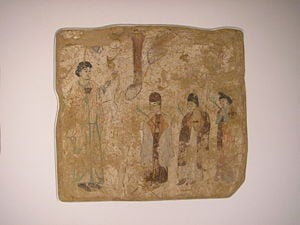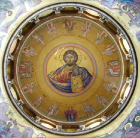Nestorianism
| |||||||
Nestorianism is the doctrine that Jesus exists as two persons, the man Jesus and the divine Son of God, or Logos, rather than as a unified person. This doctrine is identified with Nestorius (c. 386–c. 451), Patriarch of Constantinople. This view of Christ was condemned at the Council of Ephesus in 431, and the conflict over this view led to the Nestorian schism, separating the Assyrian Church of the East from the Byzantine Church.
The Assyrian Church of the East refused to drop support for Nestorius and denounce him as an heretic, and it has continued to be called "Nestorian" in the West, to distinguish it from other ancient Eastern churches. However, the Church of the East does not regard its doctrine as truly Nestorian, but rather teaches the view of Babai the Great, that Christ has two qnome (essences) which are unmingled and eternally united in one parsopa (personality). According to some interpretations, the origin of this confusion is mostly historical and linguistic: for example, the Greeks had two words for 'person', which translated poorly into Syriac, and the meanings of these terms were not even quite settled during Nestorius' lifetime.
Nestorianism originated in the Church in the 5th century out of an attempt to rationally explain and understand the incarnation of the divine Logos, the Second Person of the Holy Trinity as the man Jesus Christ. Nestorianism taught that the human and divine essences of Christ are separate and that there are two persons, the man Jesus Christ and the divine Logos, which dwelt in the man. In consequence, Nestorians rejected such terminology as "God suffered" or "God was crucified", because the humanity of Jesus Christ which suffered is separate from his divinity. Likewise, they rejected the term Theotokos (Giver of birth to God/Mother of God) as a title of the Virgin Mary, suggesting instead the title Christotokos (Giver of birth to Christ/Mother of Christ), because in their opinion Mary gave birth to only the human person of Jesus and not the divine.
Nestorius
Nestorius (c. 386–c. 451) was a pupil of Theodore of Mopsuestia in Antioch in Syria (modern Turkey) and later became Patriarch of Constantinople. He taught that the human and divine aspects of Christ were distinct natures, not unified. He preached against the use of the title Mother of God (Theotokos) for the Virgin Mary and would only call her Mother of Christ (Christotokos). He also argued that God could not suffer on the cross, as he is omnipotent. Therefore, the human part of Christ died on the cross, but not the divine.
His opponents accused him of dividing Christ into two persons: they claimed that proposing that God the Word did not suffer and die on the cross, while Jesus the man did, or that God the Word was omniscient, while Jesus the man had limited knowledge, implied two separate persons with separate experiences.
Nestorius responded that he believed that Christ was indeed one person (Greek: prosopon). Opposed by Cyril of Alexandria, Nestorius was condemned at the Council of Ephesus in 431.
The Council held that Christ is one person, and that the Virgin Mary is the mother of God. The condemning pronouncement of the Council resulted in the Nestorian schism and the separation of the Assyrian Church of the East from the Byzantine Church.[1] However, even Ephesus could not settle the issue, and the Byzantine Church was soon split again over the question of whether Christ had one or two natures, leading to the Chalcedonian schism.
Christological implications
From the point of view of the Chalcedonian theology which is held by most Western and Orthodox churches, the teaching of Nestorius has important consequences relating to soteriology and the theology of the Eucharist.
During the Protestant Reformation, when some groups denied the Real Presence and the communication of attributes between the two natures, they were accused of reviving the heresy of Nestorius.
The involvement of the Assyrian Church
Cyril of Alexandria worked hard to remove Nestorius and his supporters and followers from power. However, in the Syriac speaking world, Theodore of Mopsuestia was held in very high esteem, and the condemnation of his pupil Nestorius was not received well. His followers were given refuge. The Sassanid Persian kings, who were at constant war with Byzantium, saw the opportunity to assure the loyalty of their Christian subjects and supported the Nestorian schism:
- They granted protection to Nestorians (462).
- They executed the pro-Byzantine Catholicos Babowai who was then replaced by the Nestorian Bishop of Nisibis Bar Sauma (484).
- They allowed the transfer of the school of Edessa to the Persian city Nisibis when the Byzantine emperor closed it for its Nestorian tendencies (489).
At Nisibis the school became even more famous than at Edessa. The main theological authorities of the school have always been Theodore and his teacher Diodorus of Tarsus. Unfortunately, few of their writings have survived. The writings of Nestorius himself were only added to the curriculum of the school of Edessa-Nisibis in 530, shortly before the Fifth Ecumenical Council in 553 condemned Theodore of Mopsuestia as Nestorius's predecessor.
At the end of the 6th century the school went through a theological crisis when its director Henana of Adiabene tried to replace Theodore with his own doctrine, which followed Origen. Babai the Great (551–628), who was also the unofficial head of the Church at that time and revived the Assyrian monastic movement, refuted him and in the process wrote the normative Christology of the Assyrian Church, based on Theodore of Mopsuestia.
A small sampling of Babai's work is available in English translation. The Book of Union is his principal surviving work on Christology. In it he explains that Christ has two qnome (essences), which are unmingled and eternally united in one parsopa (personality). This, and not strict Nestorianism, is the teaching of the Assyrian Church. However, the Assyrian Church has continued to be called "Nestorian" in the West to distinguish it from other ancient Eastern churches, despite the fact that Babai's Christology is basically the same as that of Catholicism and Orthodoxy; the Baltimore Catechism teaches that Christ is one "person" (like Babai's parsopa) but has two "natures" (Babai's qnome).
The spread of Assyrian "Nestorianism"
The Assyrian Church produced many zealous missionaries, who traveled and preached throughout Persia and Central and East Asia in the seventh and eighth centuries. Also during this time many Nestorian scholars, having escaped the Byzantines, settled in Gundishapur, Persia and Muharraq in Bahrain, bringing with them many ancient Greco-Roman philosophical, scientific, and literary texts. "Nestorian" Christianity reached China by 635, and its relics can still be seen in Chinese cities such as Xi'an. About the same time Nestorian Christianity penetrated into Mongolia, eventually reaching as far as Korea. The Nestorian Stele, set up on 7 January 781 at the then-capital of Chang'an, describes the introduction of Christianity into China from Persia in the reign of Tang Taizong.
The Christian community later faced persecution from Emperor Wuzong of Tang (reigned 840–846). He suppressed all foreign religions, including Buddhism and Christianity, which then declined sharply in China. A Syrian monk visiting China a few decades later described many churches in ruin.
Nestorianism was particularly active in the 12th century, being a state religion of Khitans in the times of Yelü Dashi. It was also one of the widespread religions in the empire of Ghenghis Khan, and several Nestorian gravestones written in Syriac survive in what is today Kyrgyzstan.
The Church experienced a significant revival during the Yuan dynasty. Marco Polo in the 1200s and other medieval Western writers indicate many Nestorian communities remaining in China and Mongolia; however, they clearly were not as vibrant as they had been during Tang times. The communities seem to have petered out due to hostility from the Ming dynasty. The legacy of the missionaries remains in the Assyrian churches still to be found in Iraq, Iran, and India.
There is evidence from within the hadith that Muhammad had contact with Nestorian Christians[citation needed]. Particularly of interest are the similarities between Muslim raka'ah, or ritual prayer, and the genuflections performed by Nestorians during Lent.
Modern Nestorianism
As outlined above, the Assyrian Church of the East and the "Nestorian" Church of the East & Abroad represent a historical continuity with the Nestorian Christianity, though it is debated whether their doctrine is actually Nestorian.
The New Age metaphysical system of Theosophy teaches a Nestorian doctrine regarding Jesus Christ (See Benjamin Creme [Theosophical guru]).
External link
- “Church of the East” unofficial website.
ReferencesISBN links support NWE through referral fees
- Baum, Wilhelm and Winkler, Dietmar W (1 January 2003). The Church of the East: A Concise History, London: Routledge. ISBN 0-415-29770-2
- Jordan, James B. "Liturgical Nestorianism: A critical review of "Worship in the presence of God."" Transfiguration Press, 1994. ISBN 978-1883690038
- Lev N. Gumilev. Poiski vymyshlennogo tsarstva (in Russian, "Looking for the mythical kingdom"). Moscow, Onyx Publishers, 2003. ISBN 5-9503-0041-6.
- Nestorius and Nestorianism at the Catholic Encyclopedia
ar:نسطورية bs:Nestorijanstvo ca:Nestorianisme cs:Nestoriánství de:Nestorianismus es:Nestorianismo eo:Nestorianismo fa:نسطوریان fr:Nestorianisme gl:Nestorianismo it:Nestorianesimo he:המינות הנסטוריאנית lt:Nestoriečiai ja:ネストリウス派 pl:Nestorianizm pt:Nestorianismo ru:Несторианство sr:Несторијанство fi:Nestoriolaisuus tr:Diofizit zh:景教
Credits
New World Encyclopedia writers and editors rewrote and completed the Wikipedia article in accordance with New World Encyclopedia standards. This article abides by terms of the Creative Commons CC-by-sa 3.0 License (CC-by-sa), which may be used and disseminated with proper attribution. Credit is due under the terms of this license that can reference both the New World Encyclopedia contributors and the selfless volunteer contributors of the Wikimedia Foundation. To cite this article click here for a list of acceptable citing formats.The history of earlier contributions by wikipedians is accessible to researchers here:
The history of this article since it was imported to New World Encyclopedia:
Note: Some restrictions may apply to use of individual images which are separately licensed.

